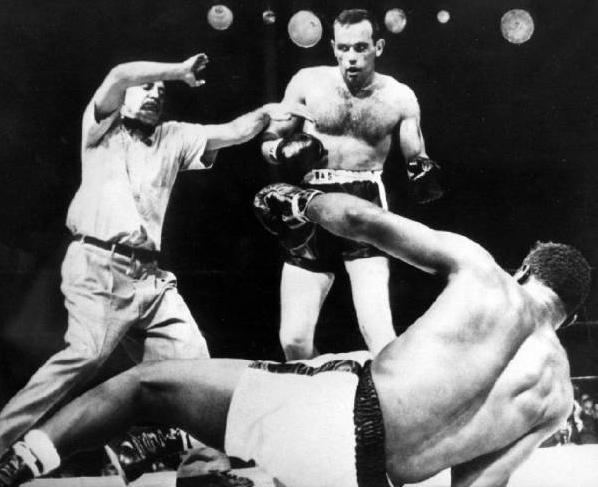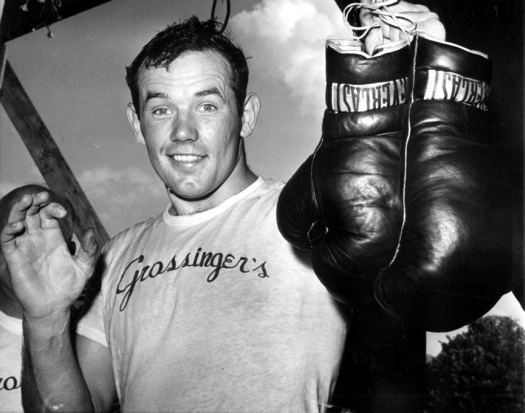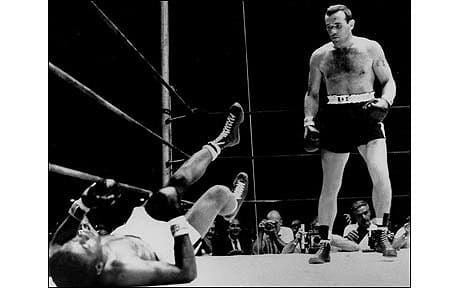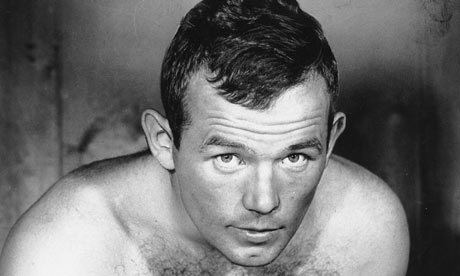Real name Ingemar Johansson Name Ingemar Johansson | Reach 183 cm (72 in) Role Boxer Nationality Swedish Height 1.84 m | |
 | ||
Nickname(s) IngoThe Hammer of Thor Born September 22, 1932Gothenburg, Sweden ( 1932-09-22 ) Spouse Edna Alsterlund (m. 1980–2009) Movies All the Young Men, Drra pa - kul grej pa vag till Gotet, Tre dar pa luffen, For tapperhet i talt Children Jean Johansson, Maria Johansson, Patrick Johansson, Thomas Johansson, Ann Johansson Similar People Ed Sanders, Hall Bartlett, Hans E Wallman | ||
Floyd patterson vs ingemar johansson i june 26 1959 round 3
Jens Ingemar Johansson ([ˈɪŋːɛmar ²juːhansˌsɔn]; 22 September 1932 – 30 January 2009) was a Swedish professional boxer who competed from 1952 to 1963. He held the world heavyweight title from 1959 to 1960, and was the fifth heavyweight champion born outside the United States. Johansson won the title by defeating Floyd Patterson via third-round stoppage, after flooring him seven times in that round. For this achievement, Johansson was awarded the Hickok Belt as top professional athlete of the year—the only non-American to do so in the belt's entire 27-year existence—and was named the Associated Press Male Athlete of the Year and Sports Illustrated Sportsman of the Year.
Contents
- Floyd patterson vs ingemar johansson i june 26 1959 round 3
- What s my line ingemar johansson burl ives martin gabel james roosevelt panel feb 1 1959
- Early years
- World heavyweight champion
- Rematch with Patterson
- Third match with Patterson
- Later career and retirement
- Life after boxing
- Legacy
- References

Johansson also held the European heavyweight title twice, from 1956 to 1958 and from 1962 to 1963. As an amateur he won a silver medal in the heavyweight division at the 1952 Summer Olympics. He affectionately named his right fist "toonder and lightning" for its concussive power (it was also called "Ingo's bingo" and the "Hammer of Thor"), and in 2003 he was ranked at No. 99 on The Ring magazine's list of the 100 greatest punchers of all time. He reputedly had recurring bone trouble in his right hand throughout his career as a result.

What s my line ingemar johansson burl ives martin gabel james roosevelt panel feb 1 1959
Early years

Johansson's introduction to the top rank of the sport was inauspicious. At age nineteen he was disqualified for passivity at the Helsinki 1952 Summer Olympics in the heavyweight competition in a fight against eventual Olympic gold medalist Ed Sanders. Johansson maintained he was not evading Sanders (who also got a warning for passivity), but rather was trying to tire his opponent. Johansson said he had been limited to a 10-day training camp, had only trained with newcomers, and had been told by his coach to let Sanders be the aggressor. Nevertheless, his silver medal was withheld for poor performance and only presented to him in 1982.

Johansson had earned his spot in the Olympics by winning the Swedish National Championship earlier the same year, 1952, after he knocked out his opponent in the first round of the final.
After the Olympics Johansson went into seclusion for six months and considered quitting boxing. However, he returned to the ring and turned professional under the guidance of the Swedish publisher and boxing promoter Edwin Ahlquist, subsequently winning his first 21 professional fights. He won the Scandinavian pro title by knocking down and outscoring the Dane Erik Jensen (breaking his right hand in the process). A broken hand and a one-year military service kept him out of the ring until late 1954. In August 1955, in his twelfth professional fight, Johansson knocked out former European Heavyweight Champion Hein ten Hoff in the first round. He took the Scandinavian heavyweight title in 1953 and, on 30 September 1956, he won the European Heavyweight Championship by scoring a 13th-round KO over Italy's Franco Cavicchi in Milan for the European title.
Johansson successfully defended his European Crown against ranked heavyweights Henry Cooper (fifth-round KO on 19 May 1957) and Joe Erskine, with a TKO in 13 on 21 February 1958.
World heavyweight champion
Johansson earned his shot at the world heavyweight crown when he knocked out top ranked contender Eddie Machen in the first round of their elimination match on 14 September 1958. In front of 53,615 fans in Ullevi football stadium, Johansson downed Machen three times, finally finishing him with a barrage of punches at 2:16 of the first round. Johansson then signed to fight champion Floyd Patterson.
Johansson was a colourful figure in New York City as he trained for the fight. Eschewing the monastic training regimen favored by Patterson and other fighters, Johansson trained at the Catskill resort of Grossingers. He did not seem to train particularly hard, and was often seen at night spots with his attractive girlfriend, Elaine Sloane, whom he asked out while she was working for Sports Illustrated.
He entered the ring in Yankee Stadium on 26 June 1959, as a 5–1 underdog. Johansson spent the first two rounds of the encounter retreating and flicking a light left jab at the champion. In the third round, Johansson threw a wide left hook that Patterson blocked with his right hand. When he moved his right hand away from its protective peek-a-boo position before his chin, Johansson drilled him with a short powerful right hand. Patterson went down, arose on unsteady legs and was out on his feet. Johansson followed up his advantage and sent Patterson down six more times in the round before the bout was stopped by referee Ruby Goldstein. Johansson celebrated with his girlfriend and future wife Birgit Lundgren and the next day a headline in a New York newspaper expressed the city's amazement. It read: "Ingo – It's Bingo." When Johansson returned to Sweden, he flew in on a helicopter, landing in the main football stadium in Gothenburg, his home town, and was cheered by 20,000 people. He appeared on the cover of Sports Illustrated, as well as the cover of Life Magazine on 20 July 1959, alongside Birgit.
Johansson was a flamboyant champion – a precursor to the "Swinging Sixties". One publication dubbed Johansson "boxing's Cary Grant" and in 1960 he appeared in the movie All the Young Men as a marine, alongside stars Alan Ladd and Sidney Poitier. Wherever he went, in the U.S. or in Sweden, he had a beautiful woman on his arm, with paparazzi snapping pictures.
To train for the third fight with Patterson, Ingemar sparred with a young Muhammad Ali, (known then as Cassius Clay) in Miami Beach. After Cassius had "boxed his way around the ring, as if it was he, using 'Ingo' as a sparring partner", somebody offered $100,000 to Ingemar to fight in a televised event with Ali, but Ingemar declined saying that the fight would not draw three ticket holders and that Ali did not have the ability to step in the ring with him at that time.
Rematch with Patterson
Johansson proposed to girlfriend Birgit in April 1960 after the champion visited Egypt. Then he turned his attention to defending his title against Floyd Patterson. The two signed for a rematch on 20 June 1960. Patterson knocked Johansson out in the fifth round with a leaping left hook to become the first man to recover the world's undisputed heavyweight title. The punch caught Johansson's chin and he hit the canvas with a thud, out cold before he landed flat on his back. With blood trickling from his mouth, his glazed eyes staring up at the ring lights, and his left foot twitching, the Swede was counted out. After the count, Patterson showed his concern for Johansson by cradling his motionless opponent, and promising him a second rematch. Johansson lay flat on his back on the canvas for five minutes before he was placed on a stool brought into the ring. He was still dazed and unsteady fifteen minutes after the knockout as he was helped out of the ring.
Third match with Patterson
Patterson and Johansson fought their final match on 13 March 1961. Johansson appeared to be in the worst physical condition of his three bouts with Patterson. A. J. Liebling, writing in The New Yorker, said the outcome seemed preordained and that Johansson was not dieting for the fight, eating creamed chicken, strawberry shortcake, and cherry cheesecake. Nonetheless the fight was competitive. Johansson caught Patterson leaping at him in the very first round and knocked him down. He followed his advantage up by scoring another knockdown, but was himself caught going in wide open by that famous Patterson left hook. It knocked him down. As the fight progressed, it became obvious that Johansson was spent. Patterson won when the referee swiftly stopped the contest in round six after Johansson had been down.
Later career and retirement
Johansson, then only 29, returned to Europe. He recaptured the European crown from Dick Richardson by an eight-round KO on 17 June 1962. By this time, Sonny Liston had captured the heavyweight crown from Patterson, and efforts were underway to match Johansson with Liston.
Johansson, however, fought journeyman heavyweight Brian London on 21 April 1963, in a non-title twelve-round match. Johansson won most of the rounds by boxing fairly well but not throwing a serious right hand punch throughout the entire fight. In round twelve, with four seconds remaining in the fight, London tagged Johansson with a powerful right hand that knocked him down flat on his back. Johansson arose at the count of four, just as the bell rang to end the fight. Film of this fight clearly illustrates Ingo was upright but groggy at the sound of the bell, but was the points winner.
The next day, the front page of Stockholm's newspapers showed a photo of him dizzy, climbing the ropes, with the headline "Wake up Ingo – You won!" After seeing this, he sat down and wrote a letter to the European Boxing Union, resigning his title and retiring from boxing at the age of 30.
Life after boxing
Ingemar Johansson and Floyd Patterson became good friends who flew across the Atlantic to visit each other every year.
Johansson made several films in Sweden and appeared as a marine in the Korean War film All the Young Men (1960). In the 1960s along with other business interests, Johansson co-promoted boxing cards in Sweden, including several with ex-champ Sonny Liston (1966 and 1967). On 22 April 1966, he boxed a five-round exhibition with European Heavyweight Champion Karl Mildenberger for his first co-promotion. He also owned a fishing boat and a bar called "Ingo's".
By the 1970s he resided in Pompano Beach, Florida, where he owned a hotel. He ran in marathons (including the Boston Marathon) all over the world until the mid-1980s. In 1985 he completed the Stockholm Marathon.
During the 1990s Johansson and Patterson would attend boxing conventions and also sign their autographs on boxing memorabilia. They continued to be friends until the onset of Alzheimer's disease incapacitated them both. It is thought the illness was of the type linked to boxing, although his career was fairly short compared to some champions. In the 1990s Johansson's business interests in Sweden included sports apparel and a light lager beer called "Hammer", named for his punching prowess.
In 2000, the Swedish Sports Academy selected Johansson as Sweden's third-best athlete of the 20th century, behind tennis great Björn Borg and Alpine skiing great Ingemar Stenmark. In 2002, he was inducted to the International Boxing Hall of Fame.
Having suffered from Alzheimer's disease and dementia since the mid-1990s, he lived in a nursing home in Kungsbacka while his health deteriorated. In the later stages of his illness, he was reunited with his second wife, Birgit, who was at his side when he died on 30 January 2009, from complications following pneumonia. At the time of his death, he was at age 76 the oldest living heavyweight champion. Johansson was married three times and is survived by five children.
In January 2011, the 1959 Johnny Lion song "Ingemar Johansson", which chronicles the 1959 Patterson fight, was re-released on the compilation album From The Vault: The Coed Records Lost Master Tapes, Volume 1.
Legacy
While his victory over Floyd Patterson was a huge upset at the time, Johansson's standing within heavyweight history is fairly poor. Considered to be an ordinary fighter with a very good right hand, the Swede was perhaps fortunate to have met Patterson, one of history's more vulnerable heavyweight champions, for the title. Patterson also likely took the challenge of Johansson lightly, given the Swede's apparently lackadaisical approach to training. This was also at a time when it was considered a virtual impossibility that a European heavyweight could inflict a defeat on an American champion on U.S soil. Furthermore, Patterson had defended the title just 56 days previously, against Britain's Brian London, and likely considered Johansson to be another inept challenger from Europe.
Johannsson's world title victory is still historically significant within European boxing, as he became only the fourth-ever European to become heavyweight champion, and the first since Primo Carnera in 1933, who lost the title to Max Baer almost exactly 25 years before Johansson's triumph. Johansson would be the last European to win the heavyweight title until Francesco Damiani became the inaugural WBO heavyweight champion in May 1989. As the WBO was a fledgling sanctioning body at the time and not considered a legitimate world title, it was not until Lennox Lewis was awarded the WBC title in 1992, 33 years after Johansson's victory over Patterson, that a European again held a recognized version of the heavyweight title. It was also not until 1999, when Lewis unified the titles against Evander Holyfield, that a European again held the undisputed heavyweight championship, as Johansson had 40 years earlier. Johansson was also the last Caucasian (and last non-American) to hold the heavyweight title until South Africa's Gerrie Coetzee won the WBA version in 1983.
Despite never successfully defending the title, Johansson can claim to have been heavyweight champion through two decades (The 1950's and 60's). He was the first heavyweight champion to lose the title to the man whom he had beaten to become champion since Ezzard Charles's loss to Jersey Joe Walcott in 1951. This would not happen again until September 1978, when Leon Spinks dropped the title back to Muhammad Ali, having beaten him in February of that year to become champion.
Outside of Europe, Johansson is best remembered as the opponent whom Patterson beat to become the first man to regain the heavyweight championship. As this loss, and the one which he suffered to the american in their third fight, are his only defeats, Johansson is one of three heavyweight champions to have retired with victories over every opponent he faced as a professional. The others are Rocky Marciano and Lennox Lewis. Although the win over Patterson to claim the heavyweight title is his most famous, Johansson's first-round victory of the undefeated american, Eddie Machen, in 1958 is also noteworthy, and provides evidence of the power the swede held in his right hand. Machen would go on to take Sonny Liston the twelve round distance in 1960, and lasted into the tenth round against Joe Frazier in 1966.
Johansson also held the European Boxing Union Heavyweight title on two occasions, scoring stoppage victories over notable continental foes such as Henry Cooper, Dick Richardson and Joe Erskine.
